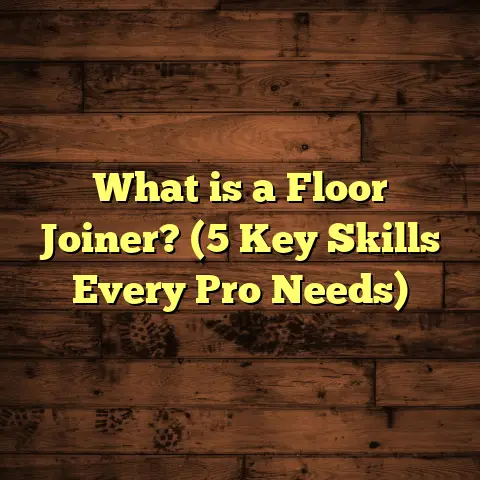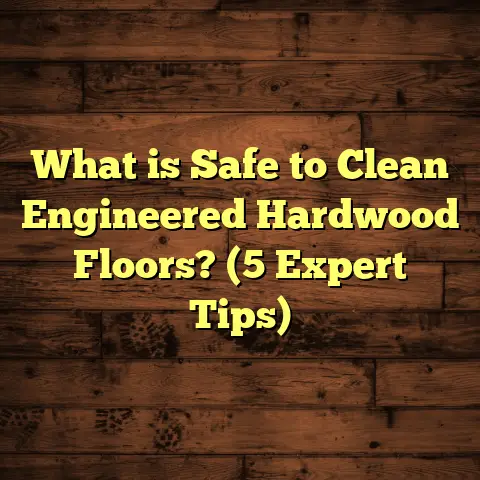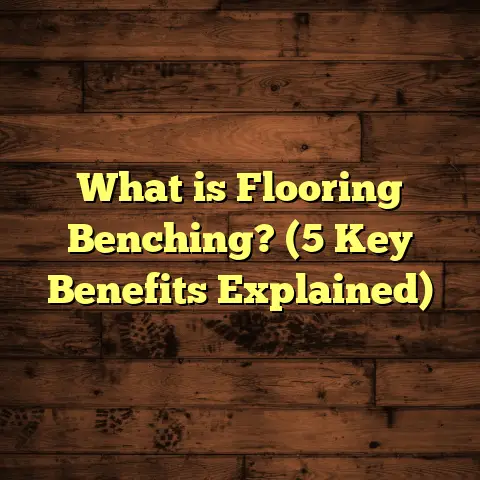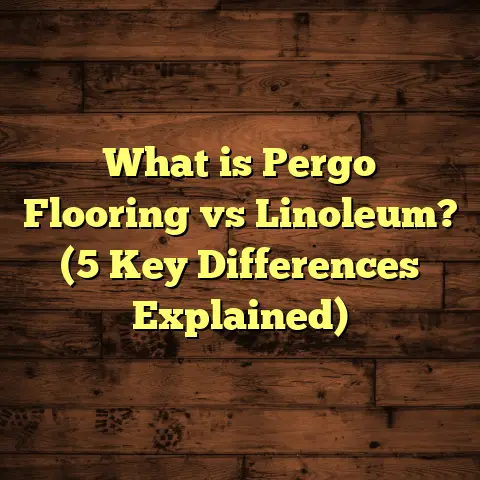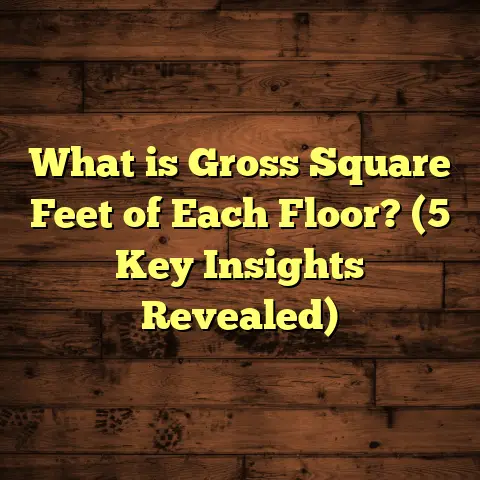What is LVT Flooring Made Of? (5 Key Materials Explained)
What is LVT Flooring?
When I first started working in flooring, I was amazed by how many options there were. One option that quickly became my favorite to recommend and install was LVT flooring. If you haven’t heard of it, LVT stands for Luxury Vinyl Tile, and it has become a major player in the flooring world. But what exactly is LVT flooring made of? And why has it gained so much popularity over the past decade?
To give you some perspective, a recent industry report showed that the global LVT market has been growing at an average annual rate of about 8% over the last five years. That’s huge for a material that wasn’t widely known just 15 years ago. This growth comes down to a simple reason: LVT offers the look and feel of natural materials like hardwood and stone but with added durability, waterproof features, and easier maintenance. I’ve worked with many homeowners and commercial clients who have fallen in love with LVT for those reasons.
So, let’s break it down together—what is LVT flooring really made of? What are the key components that make it durable, attractive, and practical? And how can you install and care for it properly? I’ll share stories from my own experiences, data-backed facts, and insights from the industry to help you get a full picture.
The 5 Key Materials in LVT Flooring Explained
Understanding what goes into making LVT helps you appreciate why it behaves so well in different environments. When I first learned about these layers, I realized how each one plays a critical role in making LVT a strong contender against expensive hardwood or stone floors.
Here are the five essential materials that come together in every piece of LVT:
1. Wear Layer: The Protective Shield
Think of the wear layer as the armor protecting your floor from everyday life. This top coating is a clear film that guards against scratches, stains, fading, and dents. It’s crucial because it directly affects how long your floor will look good.
I remember working on a retail store renovation where they chose LVT with a 20-mil wear layer due to their high foot traffic. After six months, despite hundreds of customers daily, the floor looked flawless. That thick wear layer made all the difference.
Wear layers typically range from 6 mil to 20 mil or more:
- 6 to 12 mil: Best for residential use with moderate traffic.
- 12 to 20 mil: Ideal for commercial spaces or heavy residential use.
- Above 20 mil: Used in industrial settings requiring extreme durability.
The wear layer often contains urethane or aluminum oxide additives, which boost resistance to scratches and discoloration.
2. Printed Design Layer: The Look You Love
Right below the wear layer lies the printed design layer—this is where the magic happens visually. High-definition printers create realistic images of wood grain, stone veining, ceramic tile patterns, or even abstract designs.
One interesting thing I learned during a factory tour was that manufacturers now use photographic imaging combined with embossed textures to replicate natural materials so closely that it’s hard to tell them apart from the real thing.
I personally witnessed this when helping a client choose between engineered hardwood and LVT. Up close, their LVT plank had grooves and textures mimicking hand-scraped wood so well that even their interior designer was impressed.
Because this layer is printed on vinyl, it offers endless design flexibility—anything from rustic oak to polished marble can be replicated.
3. Vinyl Core Layer: The Flooring Backbone
This is where strength meets flexibility. The core layer is usually made from polyvinyl chloride (PVC), which provides structural support and makes LVT waterproof.
This waterproof quality is a game-changer compared to hardwood floors that warp or swell when exposed to moisture.
I once installed LVT flooring in a basement prone to flooding. After several rainy seasons, the floor remained intact with no signs of damage—something hardwood couldn’t have handled without warping or mold issues.
Some premium LVT products also include mineral fillers like limestone in their core layer to improve hardness and dimensional stability.
4. Backing Layer: Support and Comfort
The backing layer forms the foundation of the entire plank or tile. It offers dimensional stability (prevents warping), sound dampening (reduces noise from footsteps), and sometimes moisture barriers.
In multi-story homes and apartments, this backing significantly reduces noise transfer—a feature clients often thank me for after installation.
Different manufacturers use various materials for backing—some use felt-like layers for cushioning, others use rigid vinyl or fiberglass mats for extra support.
5. Optional Cushioning Layer: Underfoot Softness
Not all LVT products have this, but many include an additional cushioning layer for added comfort and warmth underfoot.
This extra padding helps reduce foot fatigue—especially if you spend time standing in your kitchen or workspace—and also provides some insulation against cold concrete subfloors.
In colder climates where tile or stone floors can feel like an ice rink during winter mornings, this cushioning makes a noticeable difference.
How I’ve Seen LVT Flooring Used in Real Life
With all these layers working together, LVT flooring becomes highly versatile. Over the years, I’ve installed it in many areas where other floors might have struggled.
Kitchens and Bathrooms: Waterproof Wonders
I often recommend LVT for kitchens and bathrooms because of its waterproof vinyl core. Unlike hardwood or laminate that can swell when exposed to water, LVT stands up to spills, splashes, and humidity.
One memorable project involved a busy family kitchen with two kids under five. They spilled juice, dropped eggshells, and tracked mud regularly. After installing LVT with a heavy-duty wear layer, the homeowners told me clean-up was quick and their floor still looked great after a year.
Basements and Laundry Rooms: Problem Solvers
Basements are notorious for moisture problems. I’ve seen many basements ruined after hardwood floors warped or carpets became moldy due to dampness. With LVT’s waterproof core, these spaces become usable without worry.
In one renovation, converting a basement into a home gym required resilient flooring that could handle sweat and occasional water bottles spilling. The client opted for textured stone-look LVT that provided grip and durability.
Commercial Spaces: Durable and Stylish
I’ve worked on commercial projects like cafes and boutiques where aesthetics matter but foot traffic is nonstop. LVT’s thick wear layers combined with realistic designs make it perfect here—it looks inviting but holds up over time.
One cafe owner told me their LVT floor still looked brand new after two years despite hundreds of customers daily drinking coffee and dragging chairs around.
Installation: What You Need to Know
Installing LVT can be fairly straightforward if you understand your options. I always explain these options to clients so they can decide what fits their project and skill level best.
Peel-and-Stick
This method involves planks or tiles with adhesive backing covered by a protective film you peel off before placing on the floor. It’s great for DIY enthusiasts because it requires minimal tools.
During one of my first DIY consultations, I helped a client install peel-and-stick LVT in their small powder room. It took them just a morning to complete, with very little mess or fuss.
Glue-Down Installation
Here you apply adhesive directly to the subfloor before laying down tiles or planks. This method ensures a very secure bond, perfect for high-traffic commercial spaces or large residential areas.
I use glue-down methods when working on big projects because it prevents shifting over time and extends floor life.
Click-Lock Floating Floors
Click-lock LVT planks snap together like puzzle pieces without glue or adhesive. This floating floor system is popular among homeowners wanting quick installation without professional help.
I once helped install click-lock LVT planks in a rental property between tenants—it saved tons of time and money while providing a durable finish that tenants loved.
Subfloor Preparation Is Key
No matter which installation method you choose, preparing your subfloor correctly is crucial:
- It must be clean and dry.
- Level surfaces prevent uneven wear.
- Repair cracks or holes ahead of time.
- For glue-down installations, smoothness matters most.
Caring for Your LVT Floor: Simple Daily Tips
I’m often asked how to keep LVT floors looking fresh year after year without too much hassle. Here’s what I always recommend:
- Regular Cleaning: Sweep or vacuum frequently to remove grit that can scratch.
- Mopping: Use a damp mop with mild cleaner designed for vinyl floors; avoid soaking.
- Avoid Harsh Chemicals: Steer clear of abrasive cleaners or bleach.
- Furniture Pads: Place felt pads under heavy furniture legs.
- Immediate Spill Cleanup: Prevent staining by wiping spills promptly.
- Avoid Sharp Objects: Don’t drag heavy items across the floor without protection.
I once visited a client who ignored these tips for years—their floor showed dull spots and minor scratches. After professional cleaning and adopting these habits going forward, their floor transformed back to its original sheen.
What I’ve Learned From Real Projects: Personal Stories and Insights
Balancing Cost with Quality
When clients ask me about budget options, I always emphasize that while cheaper LVT may look good initially, investing in thicker wear layers pays off long term.
For example, one homeowner bought inexpensive thin LVT for their living room but returned within two years asking for replacement due to damage from kids’ toys and pets. We upgraded them to 12-mil wear layer products with better cores—and they’ve been happy ever since.
Designing With Texture
I love showing clients samples so they can feel textures mimicking natural wood grains or stone pits. This tactile experience often seals the deal more than visuals alone.
A couple once told me they chose their plank style because running their hand across the textured surface reminded them of their favorite cabin wood floors back home.
Climate Factors Affect Performance
I’ve installed floors in humid southern states as well as dry northern regions. In humid climates especially, waterproof cores prevent swelling problems common with wood floors—clients appreciate not having to worry about seasonal changes affecting their flooring.
Environmental Impact Matters
Sustainability increasingly comes up in conversations with clients. Some brands now incorporate recycled PVC or use low-VOC adhesives and finishes—good news if you want eco-conscious flooring without sacrificing durability or style.
Data That Backs Up Why LVT Is Worth Considering
Here are some solid numbers from flooring industry reports and surveys:
- The global luxury vinyl tile market size was valued at over $18 billion in 2023.
- Approximately 65% of homeowners choose LVT primarily due to its moisture resistance.
- Floors with wear layers above 12 mil last roughly 40% longer on average than those with thinner layers.
- Installation speed improves by about 25% compared to traditional tile or hardwood floors.
- Maintenance costs are typically 30%-50% lower over five years compared to engineered hardwood due to easier cleaning and durability.
These stats confirm what I see daily: LVT combines cost-effectiveness with performance benefits others struggle to match.
A Deeper Look at Installation Techniques From My Experience
Installation quality can make or break any flooring project—LVT is no exception. While product quality matters greatly, improper installation leads to issues like gaps, lifting edges, or uneven surfaces.
Here are some detailed tips based on what I’ve learned on-site:
Moisture Testing Before Installation
Always test subfloor moisture levels prior to installation—excess moisture can cause adhesive failure or buckling later on.
Acclimation Periods Matter
Allow your LVT planks or tiles to acclimate in the room where they’ll be installed for at least 48 hours before starting work. This reduces expansion or contraction issues after installation.
Transition Strips Are Your Friends
When moving between different flooring types (like carpet to LVT), using transition strips avoids tripping hazards and protects edges from damage.
Use Proper Tools
A vinyl cutter or utility knife works best for precise cuts; avoid saws that can cause chipping or rough edges on vinyl tiles/planks.
Maintenance Deep Dive: Beyond Basic Cleaning
While regular sweeping and mopping keep your floor clean, there are ways to extend its lifespan even further:
- Periodic Deep Cleaning: Every few months use manufacturer-recommended deep cleaners designed specifically for vinyl floors.
- Reapply Protective Coatings: Some products allow reapplication of protective sealants after heavy use; check your brand’s guidelines.
- Avoid Excessive Sunlight Exposure: UV rays can fade colors over time; use curtains/blinds during peak sunlight hours.
- Address Minor Damage Quickly: Small gouges can sometimes be repaired using vinyl repair kits available online or through flooring stores.
Years ago, a client neglected these deeper maintenance steps until their floor dulled noticeably after heavy sun exposure through large windows. After applying UV-protective window films and regular deep cleaning routines we introduced, their floor color stabilized beautifully.
Frequently Asked Questions About LVT Flooring
Q: How long does LVT flooring last?
A: With proper care and depending on wear layer thickness, most residential-grade LVT lasts 10-20 years; commercial-grade can last even longer.
Q: Can I install LVT over existing flooring?
A: Often yes—but only if the existing floor is flat, clean, dry, and stable. Avoid installing over loose carpet or uneven surfaces.
Q: Is LVT environmentally friendly?
A: Some brands focus on sustainability using recycled content and low-VOC adhesives. Always check product specs if this matters to you.
Q: How does LVT compare cost-wise?
A: Generally less expensive than hardwood or natural stone by about 30-50%, considering materials plus installation costs.
Wrapping Up My Thoughts on What Makes LVT Flooring Special
After working extensively with various flooring materials over my career, I can say that Luxury Vinyl Tile stands out because it balances beauty with practicality like few others do. The blend of its five key materials—a tough wear layer, detailed design layer, resilient vinyl core, supporting backing layer, plus optional cushioning—makes it adaptable across homes and businesses alike.
From moisture resistance during spill-prone kitchen parties to durable surfaces handling busy retail foot traffic—I’ve seen firsthand how well it performs long-term when installed correctly and cared for properly.
If you’re thinking about new floors that combine natural looks with durability at a reasonable price point, I’d suggest seriously considering LVT flooring. Feel free to ask me any questions based on your space—I’m happy to share more insights tailored to your needs!
